The Shunka Warak’in, Hyena of the Rockies

In the 1880s, the Madison Valley was still sparsely settled by whites. The hardy souls who made a go of living there learned to sleep lightly. They listened for the baying of distant wolves, and prayed they stayed distant. Something had been claiming livestock across the valley, and the loss of a cow or two opened the door to destitution.
When Israel Ammon Hutchins, Mormon settler to the Valley, heard a howl, bark, or even a yip, he was used to grabbing the rifle off the wall and storming out of the house, prepared to defend his livestock. But in 1886, he began to hear cries that sounded less like a howl than a long, keening wail. Hutchins found himself less willing than usual to rush outside. No coward, he summoned the guts to run outside and saw something chasing his wife's geese. He leveled his rifle, aimed down the sights, and pulled the trigger. His shot missed the creature but fatally wounded one of his own cows.
The snarling attacker ran into the night, unfazed.
The next time he saw it, he was luckier. His shot hit the beast. According to Israel's son, the animal tried to attack the Hutchins family in its last moments, tearing through a half-inch rope in one champing bite. He said it bled to death trying to reach and attack the family.
The strange thing was that the animal didn't look like a wolf so much as a strange hyena, with short legs and an odd, sloping back. The coat was nearly black, but a hint of stripes seemed to be visible on its flanks. As you can imagine, word circulated about the beast - the creature who had been menacing local livestock for months was dead. And it was weird - although they might have guessed as much from its terrifying, almost feminine scream.
By chance, the body of the creature was viewed by amateur taxidermist Joseph Sherwood, who offered Hutchins a cow for the oddity. Along with a sawmill and post office, the entrepreneurial Sherwood operated a combination grocery store and museum in Henrys Lake, Idaho, and he thought that the beast would make a fearsome exhibit. Using knowledge gleaned from a correspondence course in taxidermy, he mounted the creature on display, with a snarling expression still affixed to his now rigid snout.
There the creature, which Sherwood dubbed a "ringdocus," terrified and fascinated the curious until about 1980. When it disappeared.
For years the only evidence that it had ever existed, outside the memory of those who had seen it, was a grainy photograph taken and published in a 1977 book entitled "Trails to Nature's Mysteries: The Life of a Working Naturalist," written by Hutchins's grandson.
Yet even after the creature disappeared, its legend grew.
Writer and cryptozoologist Loren Coleman speculated that perhaps the beast is related to the Ioway Sioux myth of the shunka warak'in, "carries off dogs" in English. The Sioux were scared of a creatue that sometimes snatched unwary dogs and took them away, presumably to dine on them.
The association with the legend of the shunka warak'in* might be a geographic stretch, since the Ioway Sioux never reached as far West as the Madison Valley.
*Calling the beast a shunka warak'in is therefore not unlike calling every "Bigfoot" a Sasquatch, originally a Sts'ailes word for a specific spiritual entity of the Harrison River Valley in British Columbia which has become a catch-all for large hairy men of any description.
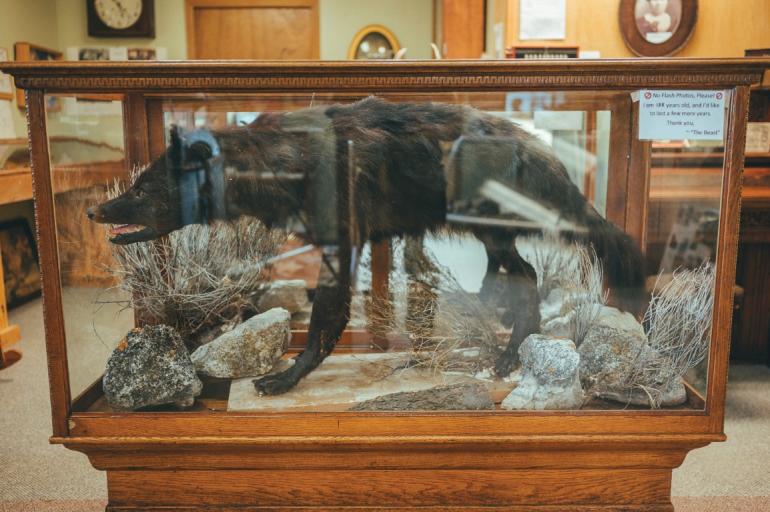
The twentieth century, too, saw plenty of rumors of large freak wolves throughout the Rockies and, indeed, America at large. In 1909 someone killed an enormous black wolf-like animal in Boise National Forest. The creature was examined by biologists in Washington D.C., who declared that they hadn't seen anything quite like it except for another anomalous sample also from Idaho. As late as 2020, a man in Pennsylvania reported seeing a "cow-sized" hyena-like creature in his headlights before it loped away at what the witness estimated was 30 to 40 mph.
Then, in 2007, the "ringdocus", shunka warak'in, whatever it was, was found. Israel Ammon Hutchins's grandson Jack Kirby discovered that all of Sherwood's taxidermied specimens had been donated to the Idaho Museum of Natural History. He found the beast under a sheet, awaiting its chance to terrify and surprise anew.
A special dispensation was arranged to house the remains in the Madison Valley History Museum. You can still see the monster there now. It is, we're told, the most popular exhibit at the museum.
But what is it?
An interesting but by no means definitive sequel to the 1886 event occurred in May of 2018, when a farmer near Denton shot a strange canid on his property. It had large, upright ears and smallish paws and fangs, and seemed to have a slope to his back. Montana Fish & Wildlife officials were cagey on what they thought it was, but they weren't bullish for wolf. The internet, naturally, did what the internet does, declaring it a direwolf, a werewolf, a chupacabra, a demon, and just a plain old dog.
The latter, incidentally, was more likely than you'd like to think; you'll probably remember when, in 2022, a 36-year-old woman shot and killed a six-month-old husky puppy and posted pictures of it, skinned, to Facebook. In the post, she gloated that "it was a great feeling to text my man and say I smoked a wolf pup."
At any rate, samples were sent away for analysis. America waited with bated breath to see what the monster was.
Meanwhile Loren Coleman himself, decades after declaring the original beast a shunka warak'in, chimed in as well. He told the Great Falls Tribune that one of the photos of the dead animal was "a picture that's gone around the world probably five times," but when pressed, opined that "I think your canid is nothing more than a roughed up sort of wolf. It looks like a wolf; maybe a German Shepard hybrid. I don't know."
Then the DNA result returned. The creature was a grey wolf, plain and simple. You've probably met some pretty strange-looking people in your life, but chances are that DNA testing would prove that they, too, were people.
Still, Hutchins's shunka warak'in is a little weirder than its recent friend. More hyena-like. And that 2018 wolf that was just a wolf wasn't reported to have screamed like a person. It didn't thrash itself to death trying to kill a family.
Sure, it could be an ugly wolf. Or just the result of overheated imaginations and imperfect taxidermy. A simple DNA test would give us the answer. Or an answer, anyway.
Luckily, no one involved wants a DNA test. Not the museum, not Hutchins's descendants.
So the mystery, like the legend, lives on.
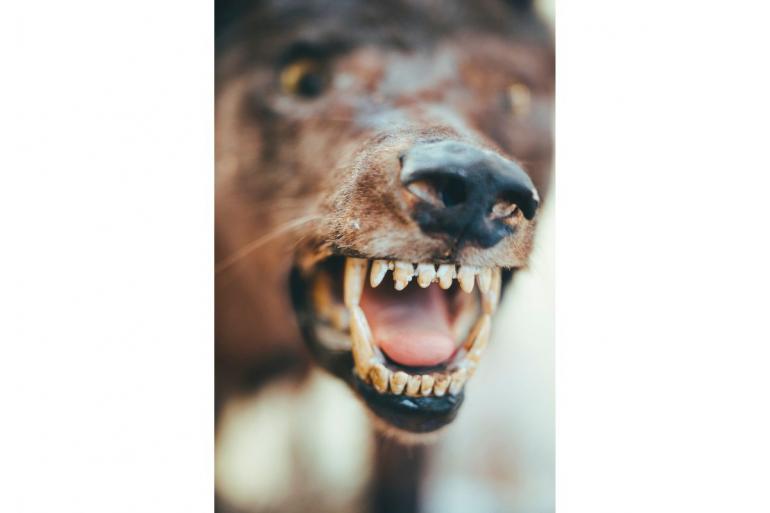
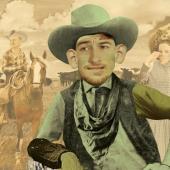



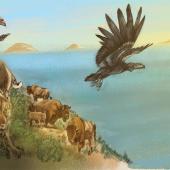





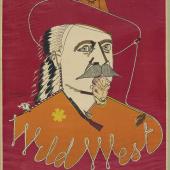

Leave a Comment Here